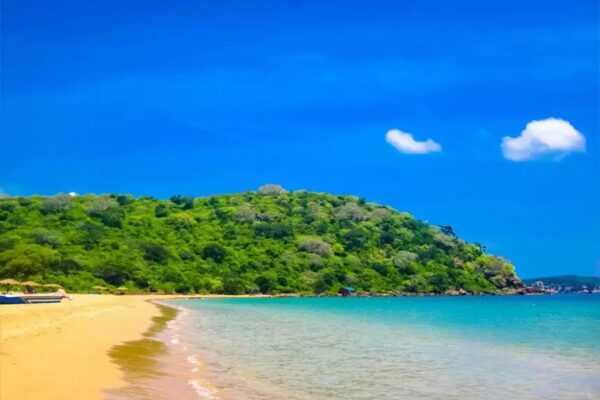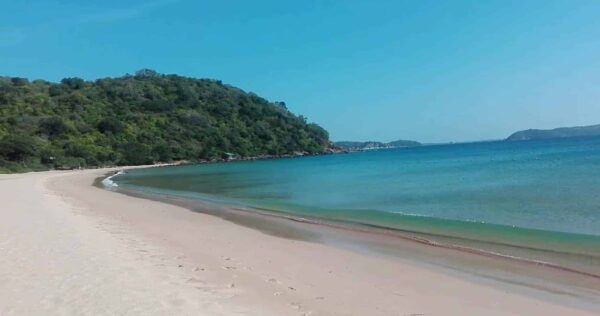Marble Beach – a pristine beach in a sheltered bay – By Arundathie Abeysinghe

 Situated approximately 17 kilometers from *Trincomalee, Marble Beach also known as “Marble Bay” is a spectacular pristine beach with crystal blue shallow waters and minimal waves and considered as an excellent bathing spot monitored by Sri Lanka Air Force. There is a resort with beach front accommodation and a restaurant operated by the Air Force located at the north end of the cove of Marble Beach. Considered as one of the best beaches in Sri Lanka, unlike many other beaches in Trincomalee, Marble Beach is located in a sheltered bay and has excellent swimming and snorkeling opportunities…
Situated approximately 17 kilometers from *Trincomalee, Marble Beach also known as “Marble Bay” is a spectacular pristine beach with crystal blue shallow waters and minimal waves and considered as an excellent bathing spot monitored by Sri Lanka Air Force. There is a resort with beach front accommodation and a restaurant operated by the Air Force located at the north end of the cove of Marble Beach. Considered as one of the best beaches in Sri Lanka, unlike many other beaches in Trincomalee, Marble Beach is located in a sheltered bay and has excellent swimming and snorkeling opportunities…
With serenity at its utmost, the stretch of sand alongside the light blue ocean seems to go on endlessly as far as the eye can see…
The allure of the Beach is its untouched, pristine splendor…
Besides the magnificent beach, the sea at the location is home to large schools of colored fish in great droves swimming close to the shore forming a dazzling underwater rainbow, a breathtaking sight…
With the still atmosphere. Marble Beach exudes a sense of serenity…
There is a naval checkpoint at the entrance to Marble Beach and it is necessary to buy a ticket before entering the Beach.
For many months of the year, the waters of Marble Beach remain typically calm and as clear as glass with light blue, placid water soothing to eyes. A unique feature of the Beach is the pristine environment unlike many beaches in Trincomalee as well as in Sri Lanka. A visitor can wade into the water at Marble Beach for a kilometer or more, yet the water will only be up to the waist or lower, depending on the tide. As the waves are very mild and calm, devoid of current or big waves, the Beach is considered as a perfect beach for kids to play. For less adventurous visitors, the sands are perfect for relaxing, entwined by the sea breeze. Visitors can bathe safely at the location as lifeguards are on duty.
*Diamond Hill situated adjacent to Marble Beach offering a fabulous view of Trincomalee and its environs is a serene escape to adventurous visitors…
There is also lots of wildlife in the area with sightings of peacocks, endemic birds and monkeys.
The best time to explore Trincomalee and its spectacular beaches is between February and August as the weather is pleasant during this period. From October to early January, due to the east coast monsoon, majority of shops, hotels and restaurants are closed.
Directions: Before the Kinniya Bridge (longest bridge in Sri Lanka – length 396 meters, connecting Trincomalee and Kinniya), there is a turn-off on the left, signposted. From there, travel on a narrow road to reach the parking space of Marble Beach. There is a naval checkpoint. It is necessary to buy a ticket to enter the Beach.
Image courtesy – attractionssrilanka.com & ceylonpages.lk
- Diamond Hill – The hill adjacent to Marble Beach was thus named by the British Colonials during the British Colonial Era, although the Hill bears no materialistic connection to the precious stone. Considered as another magnet for expeditious adventurers, Diamond Hill offers breathtaking views of the entire Trincomalee Bay that comes within its scope when viewed from its summit. The breathtaking vistas are extremely exhilarating that the mild fatigue of the hike to the summit of the hill will be more than rewarded for adventurous hikers.
- Trincomalee – Situated on one of the world’s finest natural and beautiful deep-water harbors, Trincomalee is a port city located on the northeastern coast in the Eastern Province of Sri Lanka. Ancient Gokanna also known formerly as Koddiyar Bay (meaning “Fort by the River”), Trincomalee is one of the world’s finest natural harbors. During early times, Trincomalee was a major settlement of Indo-Aryan immigrants. The first Europeans to occupy Trincomalee were the Portuguese in the 17th century. The port’s harbor was occupied by the Dutch, French and the British, until the British Colonials occupied it permanently, in 1795. Strategic significance of Trincomalee as a major British base was heightened after the Japanese ousted the British from Singapore during World War II. The British Colonials continued to hold the harbor after Sri Lanka gained independence in 1948 too, although they relinquished it, in 1957. Trincomalee has attracted seafarers, traders as well as pilgrims from Europe, Australasia, East Asia, Africa, China and Middle East from ancient periods. With a population of approximately 126000 people, Trincomalee is also a major tourist attraction and a port city visited by a large number of local and foreign tourists annually.

Fort Frederick in Trincomalee – emblazoned with colonial insignia
By Arundathie Abeysinghe
Pigeon Island – unique natural marvel
By Arundathie Abeysinghe
https://www.elanka.com.au/pigeon-island-unique-natural-marvel-by-arundathie-abeysinghe/
Sober Island – enchanting islet in Trincomalee
By Arundathie Abeysinghe
https://www.elanka.com.au/sober-island-enchanting-islet-in-trincomalee-by-arundathie-abeysinghe/
Strategic significance of Trincomalee Harbor
By Arundathie Abeysinghe
https://www.elanka.com.au/strategic-significance-of-trincomalee-harbor-by-arundathie-abeysinghe/







